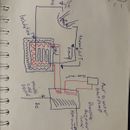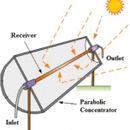Solar Collector for Hot Water
Hi, I’m generally new as a member but have been reading here for a while. I live in the south of Sweden, and we mostly have a cold climate with a few hot summer months. Even 6c it feels really cold because of the moist air. I’m currently in the process of making my house more energy efficient to meet passive house qualities, especially now after the energy price spike we suffered the last few months in Europe. It’s a two-garage house with a basement. It’s about 280m2 in size. How feasible would it be to build/buy a Solar thermal collector with Parabolic trough as the main source for hot water? You need fewer pipes compared to a flat collector. As the Heat transfer fluid, you can use thermal oil to reach a higher temperature up to 400c and not worry about water boiling off in a closed loop. Pass this heated thermal fluid down to a storage tank containing 1-2m3 of sand as the solid heat storage. Through this, you could indirectly heat your domestic hot water tank. i speculate the heating costs would be close to non-existent depending on how much 60c hot water you can extract from a 1600-3000 kg sand thermal storage with a temperature between 100-400c. Or even use it to heat the pool.
GBA Detail Library
A collection of one thousand construction details organized by climate and house part











Replies
Not very feasible. I'd challenge your assumption that "solar panels are expensive." Solar thermal is, but not solar PV (in relative terms), plus electricity is much more versatile and valuable than thermal energy . I think you could run the calculations (3000kg of sand only stores 225kwh at 400-60 C and how many kwh/year do you expect for a given array size), or you could trust that others have done the calculations before and come to the conclusion that PV is the cost efficient/feasible option (look at utility scale solar PV vs. utility scale solar thermal installations).
It’s all from the perspective of domestic use.
Installing 20kw solar array just to cover 100% of heating needs would cost 20.000$
Taking up about 120m2 of space in optimal conditions and just have an efficiency of 20% tops
Solar collectors have about 80% efficiency if insulated
And as long as I can store more Kwh of heat in the sand a day than I take out in hot water and heating it’s a giant money save. Considering almost all electricity consumed is related to hearing costs and not consumption from computers and cooking food.
More efficient, yes. Does that matter? Probably not, if it’s more expensive and generates less valuable heat. If you need about 5,000 kwh output per year for domestic hot water, you could use a heat pump water heater, which would use about 1400kwh input. That’s about 1kw of solar PV. In the US, that costs $3000 residential, $1000 utility scale. If you were already planning to use PV, the last kw is probably less. Anyway, the most money you could possibly save is $3000. Solar thermal probably comes in much higher. If a 20kw PV array costs $20,000, then install!
Just having 1kW of PV solar doesn't provide the complete solution. The majority of DHW needs occur immediately after 8-16 continuous hours of no production. His model has the storage included in the design. An alternative using PV must also include storage.
I’d contend that a hot water heater is more effective storage than sand: increase the temp within the tank as high as it’ll go during solar producing hours and mix it down. 100 gallons x (160-120) x 8.34 lbs/ gallon x (1/3412 btus/kwh) = 9.8 kwh. That’s a lot safer, easier and cheaper than heating tons of sand to 700 degrees. Either way, storage isn’t an actual requirement if net metering is available. I wouldn’t willingly help the utility.
Ok, water tank is better storage mechanism. You can't directly couple a solar panel to a water heater. You'd probably need at least 2kW of panels to get 10kWh into it on some days. It will lose about 2kWh per day.
Yes, the 400degC sand and even hotter copper pipe is pretty scary.
I don't follow you on "storage isn't an actual requirement". Can you elaborate? If we're talking about on-site generation of power with time shifted use, how can storage not be a requirement?
Trevor,
I'm guessing that Paul said storage was not an actual requirement with PV, if net metering is available, since you are storing your energy credits with the utility, instead of storing electrical or heating energy on site.
Yes, I see he's edited his comment. I'm in one of those places it's not allowed, so I never assume it. I don't know what the deal is where the OP lives.
I think net metering or not, if it costs $1/watt to install solar PV there, that’s the way forward. Even curtailing probably makes more sense than a homemade battery.
If I was to install a heatpump I would likely need to pay minimum 8.000$ excluding installation costs to replace emu old one.
20kw solar panels have a payback period of 10+ years so not super attractive,
If solar PV costs $1/watt in Sweden, that’s the cheapest option. Perhaps boring, but cheapest by far.
If you are building this yourself.....go for it, have fun. If it works okay, you can make more. Hopefully you are putting them on the ground so you can manipulate them. Flat plate panels are easy to make too as well as hot air heaters.
I would start by attempting to calculate the amount of sunlight energy captured by your reflector, and calculate the anticipated heat losses outdoors, and losses transferring heat to your storage and then to your hot water tank, to estimate the net gains you might harvest from your collector. I would guess it would work in summer during sunny periods, and not in winter during overcast weather. Weatherspark.com has some nice charts that might be helpful (see attached examples for Malmo, southern Sweden).
Ultimately, you could calculate the thermal gains obtained from your collector vs. the cost of the collector, storage and transfer, and compare to your electric bill (high in Sweden), and compare to PV and other alternatives. PV to directly heat your domestic hot water tank would certainly be simpler. Or heating the water in your pool in summer rather than indirectly via sand storage might be simpler and work well in warm summer temperatures.
Also it seems you are trying to do some experimental research, not just to save money. I would agree that its worth trying your experiment to see what you can accomplish.
I used passive solar batch water tanks on the roof of a home in Colorado, USA:
https://www.greenbuildingadvisor.com/green-homes/a-passive-solar-home-from-the-1980s
My experience was that the two heavily insulated outdoor solar-heated water storage tanks (plumbed in series) would provide hot water most of the year, except in the morning during winter (when it would only be lukewarm).
However, my Boulder, CO location is 40 degrees North latitude (similar to Spain, Italy and Greece) with a cold winter, but dry climate (sunny in winter). Malmo/southern Sweden is 55 degrees N latitude (same as Newfoundland or British Columbia, Canada) and mostly overcast in winter. However, the winter temps are a little bit colder in landlocked Boulder, CO than Malmo, Sweden. You could look up your exact location in weatherspark.com for a better analysis. And your heat storage inside your home’s excellent thermal envelope would retain more of the heat gains than the well-insulated batch tanks I used, which were outdoors (cold in winter). And whatever heat gains escaped from your sand storage would heat your home in winter. So my experience is not a great comparison. But solar gains can be used effectively, and are a sustainable source of energy for water heating.
I would expect that a water tank located inside your thermal envelope would have greater readily available heat capacity than sand. A water tank could transfer heat by convection of the water as well as by conduction, whereas sand not provide convection (movement). Although if you had fins on the pipe in sand, that would help transfer heat to and from the fluid in the pipe to the sand in the heat storage area.
It would be interesting to read about the results of your experiment in Green Building Advisor.
I tend to agree with Martin old article “Solar Thermal Is Really, Really Dead”. The last 7 years had added another Really almost every year as the cost per watt of PV panels has dropped every year.
https://www.greenbuildingadvisor.com/article/solar-thermal-is-really-really-dead